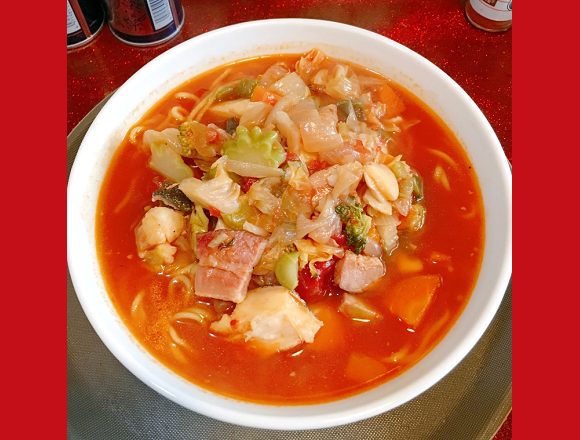
Smooth and slippery noodles are accompanied by some surprising sights.
While ramen is the type of noodle that Japan is most passionate about, the dish didn’t wholly originate in the country. Japanese-style ramen is actually the result local tinkering with the seasonings and cooking style of Chinese noodles, though the fact that it’s been going on for generations means that Japan’s ramen is now quite different from its original inspiration.
Because of this, while soba and udon, Japan’s two other popular noodle-forms, keep things pretty traditional, there’s more experimentation in the world of ramen. The first-ever ramen restaurant to be awarded Michelin star, for example, has influences from French cuisine in its use of truffle oil.
So when our Japanese-language correspondent Mr. Sato came across a restaurant in Tokyo offering “Brazilian-style ramen,” he figured it was worth a shot, because he’s always open to new culinary experiences that he can out on his expense account.
Located in the Ikebukuro neighborhood, the restaurant’s name, Akamaru, means “red circle,” and that’s exactly what you’ll see on the sign. The other distinctive decoration is, in Mr. Sato’s words, “A bone hanging from a chain attached to the building’s eves, like a baby.”
▼ Umm…this seems like an appropriate time to mention that Mr. Sato has no children.
While most ramen restaurants specialize in just noodles, Akamaru is actually only a ramen joint during the afternoon, while at night it changes into an izakaya (Japanese pub). The sign touts the restaurant’s “additive-free herb and spice fusion” fare, which intrigued Mr. Sato while keeping his vision of what he’d be eating hazy.
Taking a seat at the counter on the first floor, Mr. Sato cast his eyes over the ramen menu taped to the window. In addition to such standards as ramen with soy sauce-based and salty broths, the menu also listed something called white devil ramen. There were also black devil and red devil ramen, for those who need their food to have both an image color and a moral alignment.
But Mr. Sato, being a paragon of virtue, resisted those devilish temptations, because he had his heart set on going Brazilian with the special of the day: Brazilian-style ramen.
According to the sign advertising the unique dish, it makes use of cod, vegetables, and herbs. At 1,000 yen (US$9) it was a bit more expensive than the cheaper ramen options, but not an unreasonable price for something Mr. Sato had never seen on any other restaurant’s menu.
“Ah, so this is what Brazilian-style ramen looks like,” thought Mr. Sato as the server placed his food before him. Actually, he wasn’t sure how authentically Brazilian Akamaru’s ramen was, given that he’d neither seen nor heard of Brazilian ramen before this very day, but still, he couldn’t say it didn’t look like Brazilian ramen either.
Looking at the vibrantly colored broth, Mr. Sato could feel the rumbling in his stomach begin to pulse with a samba rhythm, but after he took a bite…
…he was tempted to sing out like a Venetian gondolier. “The flavor is pretty much minestrone,” he explained.
Of course, with minestrone enjoying widespread popularity in Japan (as well as many other parts of the world), this means that Akamaru’s Brazilian-style ramen is really tasty. There’s a strong vegetable flavor (something you’re unlikely to find in orthodox ramen), and also a touch of basil notes that please both the palate and the nose.
“I think it actually would have made more sense to call this ‘Italian-style healthy vegetable ramen,’” mused Mr. Sato. “I think it’d be really popular with female customers.”
▼ The cod was another non-traditional but delicious ingredient.
Of course, the whole reason Mr. Sato tried Akamaru’s ramen in the first place was because he wanted to find out what Brazilian-style ramen is. So in the end, it’s debatable whether the restaurant should call the dish Brazilian or Italian, but what we can say for sure is that it’s not Japanese, and not at all bad either.
Restaurant information
AKAMARU / アカマル
Address: Tokyo-to, Toshima-ku, Higashi Ikebukuro 1-13-12
東京都豊島区東池袋1-13-12
Open 11:45 a.m.-2 p.m., 6 p.m.- 10 p.m. (weekdays, Saturday), noon-4 p.m. (Sunday, holidays)
Closed Tuesdays
Photos ©SoraNews24
[ Read in Japanese ]